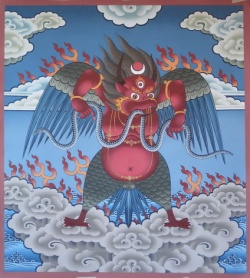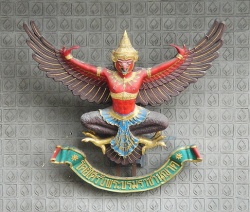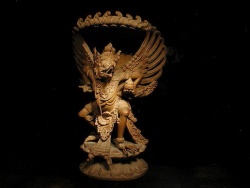Flight of the Garuda
Introduction to the chapter, Flight of the Garuda
The gentle pilgrim wanders Tibetan trails from power place to power place, sometimes passing over the high Himalayas down to the valley of Nepal. Long dreadlocks are piled on his head, and he wears a ragged patched skirt with a white shawl over his shoulders distinguishing him from most Himalayan monks. At nightfall he can sleep anywhere he finds himself, for he spent his early years in caves in the snow-capped mountains of the Tibetan plateau and cares nothing for comfort. He is vegetarian and he can fast if food is unavailable. Occasionally he may be spurned or ill-treated by bandits, but there is something about him that immediately evinces acceptance and kindness. At the house where he receives hospitality he may offer a healing charm to the sick or aged or an exorcising mantra to banish a malignant spirit. A request for help on the Dharma path is answered in a song composed spontaneously in the moment. He does not stay long in any place but leaves quickly and moves fast down the trail. This mellow yogin, an archetypal figure of the Tibetan plateau, is Shabkar Lama, Tsogdrug Rangdrol, author of The Flight of the Garuda.
Shabkar Lama was the scion of a nomad family in a tribal area in the far northeast of the Tibetan ethnic region. In this area there were no aristocratic families ensconced in their hereditary castles producing tulkus for the local establishment monasteries in each generation. His tribal society was democratic and egalitarian. His wonderful life story reflects the humility of a beggar, the magnanimity of a saint without a shred of pretension or affectation, and the good humor and compassion of a man familiar with the hardship of life on the survival line. Lacking the advantages of a princely monastic education, he was a scholar nevertheless, but a scholar who wrote from experience, directly from his heart-he lived what he wrote and taught. Free of political and social bias, following the spirit of Dzogchen, he had no time for sectarian distinctions and took initiation and instruction from not only Nyingnn lanias but teachers of every school. It was this impartial ethos that was the foundation of the great nonsectarian revival in eastern Tibet in the nineteenth century. He heralded the great Khyentse Wangpo (i 820-92), Jamgon Kongtrul Lodro Taye (1813-99), Patrul Rinpoche (1808-87), and Mipam Jamyang Gyatso (i 846-1912), who were the figures most prominent in the full blooming of the eastern Tibetan renaissance.
Shabkar Lama was born in Rebkong in Amdo in 1781. At this time the Gelugpa school dominated Amdo through its great monastic academies; but the Rebkong region, to the north of the Amnye Machen massif, was-and still is-renowned for its Nyingma yogin-tantrikas (ngagpas) guided by the Dzogchen tradition. They were respected for their total commitment and devotion, but with their unshorn hair and unkempt appearance, roaming throughout Tibet, they were also feared. Practicing ritual magic for villagers while on pilgrimage, they also taught Tantra and Dzogchen to those ready and willing to learn. Shabkar grew up in this ngagpa ambience, receiving transmission from several Nyingma masters before taking full ordination with a Gelugpa lama at the age of twenty. Thereafter the Dzogchen ethos of Rebkong remained his heart practice, indicated by the white and red shawl he wore, while his gelong ordination, the outward show, was indicated by the patched lower robe. After ordination he was directed not to monastic discipline but to the lama who was to become his root guru and inspiration throughout his life, whose name was Ngakyi Wangpo.
The Lord of Dharma Ngakyi Wangpo (1736-I 807) was a descendant of the Mongol prince Gushri Khan, and his extended family was the ruling family in an area south of Rebkong and the north of the Amnye Machen range. Ngakyi Wangpo was a secular leader and a married lama, a ngagpa. We may see this personage as a severe and uncompromising preceptor, like Marpa Dopa, Milarepa's master; but Shabkar paints him only as the most gracious and compassionate of teachers. His principal gift to Shabkar was the initiation, transmission, and instruction upon the revealed cycle of The Wishfulfilling Union of Tamdrin (Hayagriva) and Dorje Pagmo (Vajravahari). This comprehensive cycle of theory and practice provided Shabkar with his personal buddha-deity (yidam)-the union of Hayagriva and Vajravarahi. It also gave him a manual of meditation and yoga practice that was to sustain him for the remainder of his life.
After initiation Shabkar spent some time in retreat, practicing the preliminary techniques, the creative and fulfillment stages, and Dzogchen- Cutting Through and Immediate Crossing-according to the Wish-fulfilling Union of Tarndrin and Dode Pagmo, his lama's chief practice and now his own. Then after spending more time with his lama, when he received all the initiations of his lineage, he entered a further period of rigorous retreat. In the middle of the Kokonor Lake, the vast Turquoise Blue Lake sacred to Avalokiteshvara, is an island called Great God Heart of the Lake, Tsonying Mahadewa. Since no boat was permitted to sully the lake, the island could only be reached on foot by crossing the ice that covers the lake for a brief period each year. Yogins would provide themselves with a year's provision and isolate themselves in the perfect solitude on the island at the center of the lake mandala. Shabkar remained there three years practicing the maha-, anu-, and ati- yogas of the Tamdrin-Pagmo cycle. During his sojourn on this island Shabkar wrote The Flight of the Garuda. It was an early work of his genius.
Shabkar was known as an incarnation of Milarepa, Tibet's great yogin and composer of divine songs extempore, and his lama, Ngakyi Wangpo, as an incarnation of Marpa the Translator, the patriarchal yogin. Milarepa's talent in composing and singing mystical songs extempore was shared by Shabkar, and so was his propensity for the anchorite's life. But the yogin from Rebkong in Amdo was also a wanderer, roaming on pilgrimage throughout the Tibetan heartland and beyond. Punctuating his pilgrimage with retreats in caves and hermitages, he visited Amnye Machen, Amdo's sacred mountain; he performed the Tsari Rongkhor (the long circumambulation of the Tsari mountain); and he spent a year at Kang Rinpoche, on Mount Kailash. On his pilgrimage to Labchi, to the west of Mount Everest, it was said of him that wherever he traveled he left the people established in the Dharma, and wherever he stepped he converted "black:' or tarnished, worldlings into "white," or refined, practitioners. Thus he gained his sobriquet Shabkar (White Foot). During his pilgrimage, between retreats, he would continue his instruction at the feet of lamas of every school, particularly the Drugpa Kagyu, with which his own heterogenous brand of yogin-monk mix had a strong affinity. However he was also interested in the Kadampas (the school founded by Jowo Atisa and assimilated by the Gelugpas), and Je Tsongkhapa himself, whose great work, The Stages of tile Pat/i, received sustained attention from Shabkar.
Shabkar's study and practice bore fruit in his own writing. He had the gift of speed writing. It was said that he could write a hundred pages daily. If so, he could have spent only a month or so to produce his thirteen volumes of writing, the chief of which concerned his principal practice, the Tamdrin Pagmo cycle. Other volumes treated the Kadampa School, bodhisattvahood, the Nyingma tantras, and Manjushri, demonstrating the wide purview of his scholarship. Shabkar's rounded personality is evinced also by his meritorious works: the gift of a solid-gold butter lamp to the great monastery of Samye; the gilding of the superstructure of the Boudhanath Stupa in Kathmandu; the construction of numerous monasteries and temples in his own Arndo homelands. No antisocial, cantankerous hermit, he had the bodhisattva's ability to transform himself into a receptacle of offerings that he used for the good of all sentient beings.
Shabkar passed away in 1851 at the age of seventy-one. On the completion of a long discourse to his disciples, his spirit left his body while he still sat upright in lotus posture. So passed the carefree spirit of the "little anchorite" who, in many ways, both by example and in words, did more to feed the faith and support the spiritual needs of the common people than a multitude of tulkus on brocaded thrones. His spirit returned to inhabit another body, but it did so in the obscurity in which the original Shabkar spent much of his hfe. His lineage, however, proliferated. Trulshik Rinpoche of Thubten Choling in Solu, Nepal, is the principal contemporary practitioner of his lineage.
That, then, is the Shabkar Tsogdrug Rangdrol who wrote and sang The Flight of the Garuda. In his own judgment he was a simple, perspicacious mendicant without a care in the world. The clarity and power of the succinct, simple expression for which he is justly renowned is evident on every page of his work. The Flight of the Garuda also demonstrates the writer's eclectic erudition and the fertile memory that allowed him in his extempore compositions to quote or paraphrase verses of Saraha's Dohakosa, for instance, and passages from Longchenpa's Dzodun, among the works that he hsts in his colophon.
The Garuda of the title refers to a mythological bird, the Khading, or Khyung, of ancient Bon legend. It may have been that Khading and Khyung originally represented the powers of light and darkness in the eternal conflict of Manichean Bon myth. The Manichean influence on Bon was derived from countries to the northwest of Tibet. Later, Khyung and Khading were confounded, and the bird came to represent the Bon spirit of fire. It is to be found, for example, in the upper left-hand corner of prayer flags. When the Sanskritic tradition of Buddhism became dominant in Tibet, both Khading and Khyung were assimilated into the Garuda. In the Vedic mythology of ancient Aryan India, it was Garuda who stole the nectar of immortality from lndra, the king of the gods, in much the same way as the cosmic bird Zu stole the Tablets of Destiny from the gods in Babylonian myth. In the later Indian context, Garuda became the vehicle of Vishnu, the lord of preservadon and order in the cosmos, and particularly Lord Krisna's vehicle. Also, in the Pural2as and epics, as a fire spirit, Garuda features as the implacable enemy of the naga water spirits. In Tibetan Buddhist Tantra, Garuda represents the energy of fire that heals naga-related diseases, particularly cancer.
In the Great Perfection, Garuda is seen to represent the Dzogchen yogin. The nature of the bird is illuminated by the ancient Bon myth that relates how, at the beginning of time, the Khyung manifested spontaneously out of the cosmic egg as a fully mature being. The Garuda can transfer itself instantaneously from one place to another. From the tantric tradition is derived the image of the garuda's wings beating in unison to demonstrate the unitary nature of duality, particularly the simultaneous arising of the gender principles of skillful means and perfect insight. Then from nature, observing the flight of the Tibetan eagle vulture, the Dzogchen yogin can perceive an analog of his own effortless path. The bird in flight is a wonder to behold. Gliding for miles using the wind's currents to support its weight, its instinctual mastery of aeronautics is incomparable. The same kind of natural, intu- itive faculty that coordinates the bird's flight governs the Dzogchen yogin's activity.
The two wings that beat in unison in the garuda's poetic flight are form and meaning. Unfortunately the abstract, technical content of The Flight of the Garuda does not lend itself to versification and poetic expression in English, so that the balance in Shabkar's songs is not reflected in this translation, in which poetic form and rhythm have been sacrificed to clarity of meaning. Often, several words are required to render a single technical term into English, and it is impossible to maintain a regular meter. Rather than attempt unsatisfactory versification, I have translated these songs into prose, which is a more suitable medium for their metaphysical and technical vocabulary. Still, the Garuda's flight should appear effortless, its wings beating in unison.


